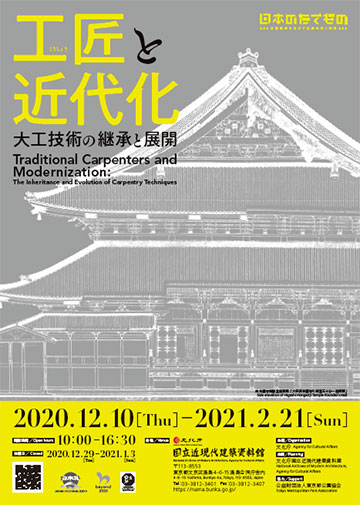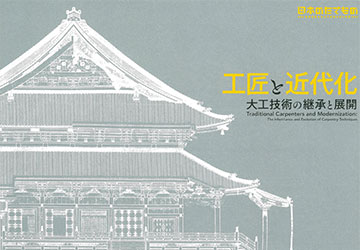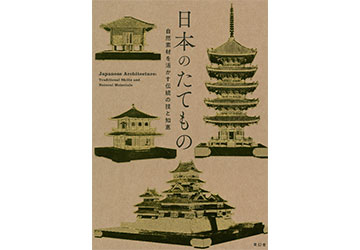Traditional Carpenters and Modernization : The Inheritance and Evolution of Carpentry Techniques
 |
2020.12.10[Thu]-2021.2.19[Fri.] |
|---|
“Traditional Carpenters and Modernization : The Inheritanc and Evolution of Carpentary Techniques” was end.
Catalogue
● Traditional Carpenters and Modernization
The Inheritance and Evolution of Carpentry Techniques

The catalogue of the exhibition is distributed at the reception.
● Japanese Architecture
Traditional Skills and Natural Materials

The catalogue of the exhibition is available at the Tokyo National Museum .
With “Kyu-Iwasakitei-teien(Former Iwasaki’s residence and garden)” temporary closing is still continued because of counter measure and prevent infection spread of COVID-19, National Archives of Modern Architecture is also continued temporary closing as follows.
In addition to this, end of the terms of exhibition “Traditional Carpenters and Modernization : The Inheritance and Evolution of Carpentry Techniques” is changed as 19th February.
It had already informed that the end of the terms had been 21th February, however, 20th and 21th are temporary closing, therefore, 19th is last day.
You are requested to check your schedule and the terms of the exhibition again.
Details is follows.
9th January 2021 Temporary closing
10th January 2021 Temporary closing
11th January 2021 Temporary closing
From 12th to 15th January 2021 Open (You can access to NAMA only main gate of Yushima local government office complex)
16th January 2021 Temporary closing
17th January 2021 Temporary closing
From 18th to 22th January 2021 Open(You can access to NAMA only main gate of Yushima local government office complex)
30th January 2021 Temprary closing
31th January 2021 Temporary closing
From 1st to 5th February Open(You can access to NAMA only main gate of Yushima local government office complex)
6th February 2021 Temporary closing
7th February 2021 Temporary closing
From 8th to 10th February Open (You can access to NAMA only main gate of Yushima local government office complex)
11th February 2021 Temporary closing
12th February Open (You can access to NAMA only main gate of Yushima local government office complex)
13th February 2021 Temporary Closing
14th February 2021 Temporary Closing
From 15th to 19th February Open (You can access to NAMA only main gate of Yushima local government office complex)
This year’s collection showcase, Traditional Carpenters and Modernization The Inheritanc and Evolution of Carpentary Techniques is formatted in accordance with the guidelines to prevent the spread of COVID-19.
Held as part of the Japan Cultural Expo, the Architecture of Japan program encompasses three nearly contemporaneous exhibitions showcasing architectural models and related materials to illuminate the characteristics of Japan’s traditional culture of wooden architecture. While the exhibition at the Tokyo National Museum focuses on antiquity through the early modern period, and the one at the National Museum of Nature and Science concentrates on modern Japan, at the National Archives of Modern Architecture we have tried to tie the two together by visually capturing the reality of modernization as it was advanced through traditional techniques of wooden architecture during the period of transition between the early modern and the modern.
To capture the continuity between the early modern and the modern, this exhibition treats the period of modernization as extending from the late Edo Period through the Taisho Period (that is, from around 1800 through the 1920s)in other words, as the nineteenth century broadly defined. For both Japan and the West (Europe and the United States), the modernization that took place during this period was a revolutionary transformation such as has rarely been seen in history.
With respect to our exhibition’s theme, I want to emphasize that modernization in Japan was pursued through a process of Westernization, of modeling itself on the West, which had been the first area of the world to modernize. Exhibitions and research to date have focused on Westernization as something driven rapidly from the outside or from above, and have spotlighted the architects in Japan both Western and Japanese who were capable of putting the knowledge, techniques, and styles of Western architecture into practice. At the same time, however, there was also a modernization from within that was pursued gradually by the craftsmen who were heir to the traditional techniques of Japan’s wooden architecture.
In this exhibition, we focus on three hereditary families of carpenters the Iwaki of Toyama Prefecture, the Kubota of Kagawa Prefecture, and the Uchida of Gifu Prefecture as examples of such craftsmen, using architectural materials such as the plans, sculptural designs, documents, correspondence, books of architectural techniques, and carpentry tools that they left behind to reveal the paths followed by each. In addition, we also look at how their activities overlap with those of leading figures in the world of Japanese architecture such as Ito Heizaemon IX (1829-1913), Oshima Mitsumoto (1842-1925), Kigo Kiyoyoshi (1845-1907), and Ito Chuta (1867-1954). Organized in this way, the exhibition seeks to reveal the breadth of its theme: Traditional Carpenters and Modernization:The Inheritance and Evolution of Carpentry Techniques.
Organization: Agency for Cultural Affairs
Planning: National Archives of Modern Architecture, Agency for Cultural Affairs
Support: Tokyo Metropolitan Park Association
Venue
National Archives of Modern Architecture, Agency for Cultural Affairs 4‐6‐15 Yushima, Bunkyo-ku, Tokyo
Entry
There are two ways to enter the National Archives of Modern Architecture.
To view only the exhibition (possible only on weekdays):
Please enter via the main gate of the Yushima
Local Common Government Offices (Admission: Free).
To view both the exhibition and Kyu-Iwasaki-tei Gardens:
Please enter via the Kyu-Iwasaki-tei Gardens
(Admission: 400 yen).
Request for visitors
Photography is prohibited. Photographable place is lobby and entrance, and partly exhibit. You can see the photographable exhibit with a stamp.
As a part of countermeasure of COVID-19 infection prevention, you are asked to write down your name and contact number etc., temperature check, clean your fingers thoroughly at the gate of exhibition area.
In the case fever is present, feeling of unwellness, you are asked to return your home.
Lastly, you are asked to keep distance with other visitors, and keep silence as possible as you can.
Our countermeasure of COVID-19 infection prevention
1 Keep sufficient cleaning,sterilization and air ventilation
2 Limited visitors at exhibition room.
3 Keep enough distance for countermeasure of it, a touch-screen tablet and sample catalog are not placed.
4 Our staff wear the mask or face shield.
About the catalogue of the exihibition
The catalogue of the exhibition is distributed at the reception.
About the exhibit
Some exhibit is still finalizing.
